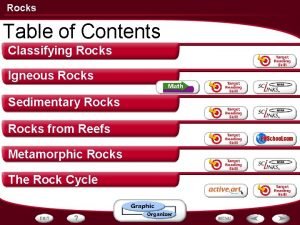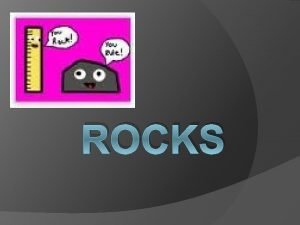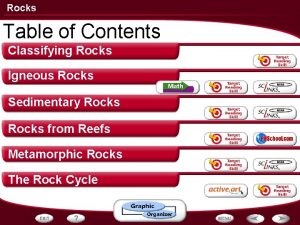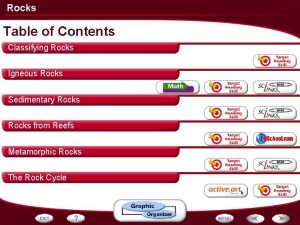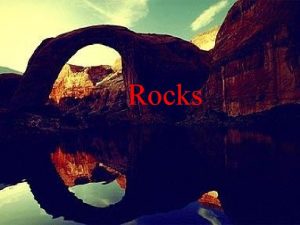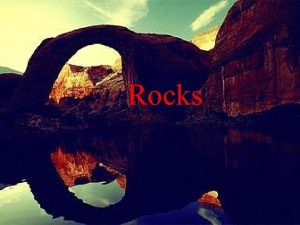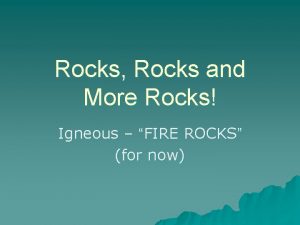Rocks 8 th grade Earth Science Classifying Rocks














- Slides: 14

Rocks 8 th grade Earth Science

Classifying Rocks Mineral Composition – rocks are made of mixtures of minerals and other materials. Some contain a single mineral. Others contain several minerals. l Color – color provides clues to the rock’s mineral composition. (Ex: granite = light basalt = dark) l Texture – the look and feel of the rock’s surface. They use shape, size and pattern. l Origin – how the rock is formed. l

3 Types of Rocks l There are 3 major groups of rocks: l Igneous Sedimentary Metamorphic l l

Igneous Rocks l l l The name igneous comes from a Latin word meaning “fire”. Igneous rocks can be either intrusive or extrusive rock. Extrusive – formed from lava that erupted onto the Earth’s surface. Basalt is the most common extrusive rock. Intrusive – formed from magma that hardens beneath the Earth’s surface. Granite is the most common intrusive rock.

Igneous Rocks Obsidian extrusive Granite intrusive

Sedimentary Rocks l Sedimentary rocks are formed through a series of processes: l Erosion Deposition Compaction Cementation l l l

Sedimentary Rocks l l Erosion – water, wind or ice loosen and carry away fragments of rock. Deposition – sediment settles out of the water or wind carrying it. Compaction – process that presses the sediments together. Cementation – dissolved minerals crystallize and glue particles of sediment together.

Types of Sedimentary Rocks l There are 3 major groups of sedimentary rocks: l Clastic – forms when rock fragments are squeezed together. Organic – remains of plants or animals are deposited in thick layers. Chemical – when minerals that are dissolved in a solution crystallize. l l

Sedimentary Rocks l Clastic sandstone l Organic coal l Chemical limestone

Metamorphic Rocks l Heat and pressure deep beneath Earth’s surface can change any rock into metamorphic rock. l Geologists classify metamorphic rocks according to the arrangement of the grains that make up the rocks.

Metamorphic Rocks l There are 2 classifications for metamorphic rocks: l Foliated – have their grains arranged in parallel layers or bands. l Nonfoliated – mineral grains are arranged randomly. They do not split into layers.

Metamorphic Rocks l Foliated gneiss l Nonfoliated quartzite

The Rock Cycle l The rock cycle is the series of processes on Earth’s surface and in the crust and mantle that slowly change rocks from one kind to another.

 Rock cycle song (sedimentary igneous metamorphic)
Rock cycle song (sedimentary igneous metamorphic) Igneous metamorphic and sedimentary
Igneous metamorphic and sedimentary Low grade and high grade metamorphic rocks
Low grade and high grade metamorphic rocks Earth science grade 9
Earth science grade 9 Science jeopardy 8th grade
Science jeopardy 8th grade How to classify rocks
How to classify rocks Igneous rocks
Igneous rocks Classifying rocks
Classifying rocks What's your favourite lesson
What's your favourite lesson Kingdom phylum class order
Kingdom phylum class order Observing and classifying
Observing and classifying Classifying science process skills
Classifying science process skills The science of naming and classifying organisms
The science of naming and classifying organisms Extrusive vs intrusive igneous rocks
Extrusive vs intrusive igneous rocks Andesite vs granite
Andesite vs granite






